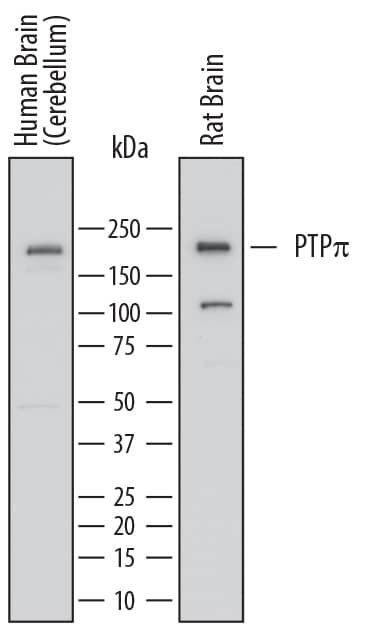Human/Rat PTPπ/PTPRU Antibody
R&D Systems, part of Bio-Techne | Catalog # MAB7475

Key Product Details
Species Reactivity
Validated:
Human, Rat
Cited:
Human, Rat
Applications
Validated:
Western Blot
Cited:
ELISA Detection, Western Blot
Label
Unconjugated
Antibody Source
Monoclonal Mouse IgG1 Clone # 764209
Product Specifications
Immunogen
Mouse myeloma cell line NS0-derived recombinant human PTPπ/PTPRU
Glu19-Gln740
Accession # Q92729
Glu19-Gln740
Accession # Q92729
Specificity
Detects human and rat PTPπ/PTPRU in Western blots and recombinant human PTPRU in direct ELISAs. In direct ELISAs, no cross-reactivity with recombinant human (rh) PTPRK, rhPTPRM, or rhPTPRT is observed.
Clonality
Monoclonal
Host
Mouse
Isotype
IgG1
Scientific Data Images for Human/Rat PTPπ/PTPRU Antibody
Detection of Human and Rat PTPπ/PTPRU by Western Blot.
Western blot shows lysates of human brain (cerebellum) tissue and rat brain tissue. PVDF membrane was probed with 0.5 µg/mL of Mouse Anti-Human PTPp/PTPRU Monoclonal Antibody (Catalog # MAB7475) followed by HRP-conjugated Anti-Mouse IgG Secondary Antibody (Catalog # HAF018). A specific band was detected for PTPp/PTPRU at approximately 180-200 kDa (as indicated). This experiment was conducted under reducing conditions and using Immunoblot Buffer Group 1.Detection of Human PTP pi/PTPRU by Western Blot
An immunoblot analysis was performed to determine the expression levels of EPAS1, PTPRU and beta-catenin in response to miR-184 or miR-574-5p in SCLC cell linesA. miR-184 overexpression inhibited EPAS1 and beta-catenin in H446 and H2227 cells, whereas miR-184 inhibition had the opposite effects. B. miR-574-5p overexpression inhibited PTPRU and enhanced the tyrosine phosphorylation of beta-catenin in H446 and H2227 cells, whereas miR-574-5p inhibition had the opposite effects. Image collected and cropped by CiteAb from the following open publication (https://pubmed.ncbi.nlm.nih.gov/26587830), licensed under a CC-BY license. Not internally tested by R&D Systems.Applications for Human/Rat PTPπ/PTPRU Antibody
Application
Recommended Usage
Western Blot
0.5 µg/mL
Sample: Human brain (cerebellum) tissue and rat brain tissue
Sample: Human brain (cerebellum) tissue and rat brain tissue
Reviewed Applications
Read 2 reviews rated 4 using MAB7475 in the following applications:
Formulation, Preparation, and Storage
Purification
Protein A or G purified from hybridoma culture supernatant
Reconstitution
Sterile PBS to a final concentration of 0.5 mg/mL. For liquid material, refer to CoA for concentration.
Formulation
Lyophilized from a 0.2 μm filtered solution in PBS with Trehalose. *Small pack size (SP) is supplied either lyophilized or as a 0.2 µm filtered solution in PBS.
Shipping
Lyophilized product is shipped at ambient temperature. Liquid small pack size (-SP) is shipped with polar packs. Upon receipt, store immediately at the temperature recommended below.
Stability & Storage
Use a manual defrost freezer and avoid repeated freeze-thaw cycles.
- 12 months from date of receipt, -20 to -70 °C as supplied.
- 1 month, 2 to 8 °C under sterile conditions after reconstitution.
- 6 months, -20 to -70 °C under sterile conditions after reconstitution.
Background: PTP pi/PTPRU
Long Name
Receptor-type Protein Tyrosine Phosphatase pi
Alternate Names
FMI, GLEPP1, PCP-2, pi R-PTP-Psi, PTP-J, PTP-PI, PTPRO, PTPRU, R-PTP-U
Gene Symbol
PTPRU
UniProt
Additional PTP pi/PTPRU Products
Product Documents for Human/Rat PTPπ/PTPRU Antibody
Product Specific Notices for Human/Rat PTPπ/PTPRU Antibody
For research use only
